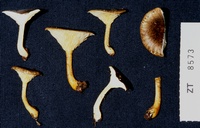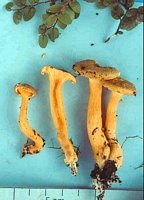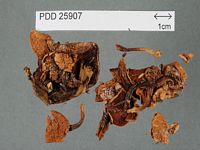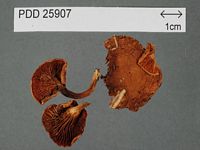|
 Hygrophoropsis aurantiaca Hygrophoropsis aurantiaca
SynonymsHygrophoropsis coacta
Agaricus aurantiacus
Clitocybe aurantiaca
Cantharellus aurantiacus
BiostatusPresent in region - Indigenous. Non endemic
Images (click to enlarge)
Caption: ZT8573
Owner: E. Horak: © Creative Commons Attribution-Noncommercial 3.0 New Zealand | 
Caption: Hygrophoropsis coacta: spores. | 
Owner: Karl Soop | 
Caption: Dried type specimen
Owner: Herb PDD | 
Caption: Dried type specimen
Owner: Herb PDD |
Article: McNabb, R.F.R. (1969). The Paxillaceae of New Zealand. New Zealand Journal of Botany 7(4): 349-362 (http://www.rsnz.org/publish/abstracts.php).
Description: PILEUS: plano-convex when young, becoming centrally depressed or shallowly infundibuliform
at maturity, 1.5-5 cm diam., dry, subglabrous or extremely finely felted, pallid
yellow, pallid orange-yellow, or occasionally with faint apricot tints; cuticle
composed of more or less repent, loosely interwoven, thin-walled, filamentous
hyphae 4.5-8.5 µm. diam. with conspicuous clamp connections; margins strongly
involute when young, moderately involute and often undulate and irregularly
lobed at maturity. LAMELLAE: moderately crowded, deeply decurrent, repeatedly
dichotomously branched 3-5 times, edges acute or occasionally bluntly rounded,
1-1.5 mm deep, pallid orange, salmon, or pallid yellowish orange at maturity.
STIPE: 1.5-4 cm long, subequal or tapering basally, 3-8 mm diam. apically, 2-5
mm diam. basally, central or somewhat eccentric, solid or stuffed, dry, glabrous,
subglabrous, or faintly longitudinally felted, concolorous with lamellae or
sordid yellowish orange; veil absent.
SPORES: spore print not obtained; spores hyaline or faintly yellowish in KOH,
pseudoamyloid, broadly elliptical, short cylindrical with obtuse ends, or occasionally
subreniform, minutely apiculate, germ pore absent, 5.8-7.2-(8.5) X 3.2-4.2 µm.
slightly thick-walled, smooth. HYMENIUM: basidia hyaline, subclavate to clavate,
20-28 X 5-6.5 µm., 4-spored; cystidia absent but a few sterile, paraphysis-like
structures present, projecting to 10 µm. beyond basidia. HYMENOPHORAL TRAMA:
bilateral, mediostratum of subparallel or loosely interwoven hyphae, lateral
stratum of closely packed, irregular, non-divergent hyphae; clamp connections
present. CONTEXT OF PILEUS: white or tinted yellow, extremely soft, unchanging
on exposure to air. TASTE: not distinctive.
Habitat: HABITAT: Gregarious under Leptospermum
and Nothofagus.
Notes: Hygrophoropsis coacta closely resembles H. aurantiaca (Wulf. ex Fr.)
Maire but differs in the glabrous, subglabrous or finely felted pileus and stipe.
In H. aurantiaca, both pileus and stipe are velutinate to tomentose and
the cuticle is formed by a trichodermium of interwoven, erect hyphae.
The organization of the hymenophoral trama is not easy to determine, as lamellae
tend to split down the line of the mediostratum. However, the tramal hyphae
are organised into an axial mediostratum and a closely packed lateral
stratum as described for the genus by Singer (1962) and are not without organisation as indicated by Corner (1966). Singer's interpretation
of the hymenophoral trama of Hygrophoropsis has been supported by the
observations of Reid (1967).
H. coacta may be recognised by the pallid yellow, orange-yellow,
or apricot tinted fruitbodies, repeatedly dichotomously branched lamellae, and
the short pseudoamyloid spores. The characteristic colours of fresh fruitbodies
are largely retained on drying.
Article: Horak, E. (1980) [1979]. Paxilloid Agaricales in Australasia. Sydowia 32: 154-166.
Notes: Two well developed collections of H. coacta McNabb have been made in New Zealand. All macro- and microcharacters observed indicate that this fungus is conspecific with H. aurantiaca (Fr.) a wide spread species both in the northern hemisphere (Bigelow 1975: 63) and in temperate South America (Singer 1964: 98).
According to Corner (1966: 132) H. aurantiaca (Fr.) is already reported from Australia and for that reason the New Zealand records extend the area of distribution in Australasia.
|